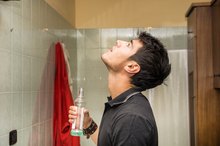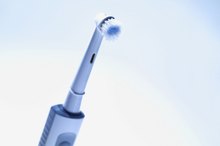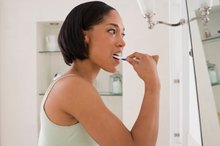How to Clean Clear Retainers
Once you get those annoying braces off your teeth, your dentist will likely recommend you wear a retainer for some time to help keep the teeth in place. A clear plastic retainer goes over your teeth, which means it’s exposed to plaque, tartar and bacteria from your mouth. This can lead to the retainer starting to smell, which then leads to bad breath. Break this nasty cycle by cleaning your retainer each day.
Rinse the retainer under warm water every time you remove it from your mouth.
How to Clean a Toothbrush
Learn More
Scrub the retainer with a toothbrush and mild dish soap. Don’t use the same toothbrush you use on your teeth; instead, designate a toothbrush specifically for cleaning your retainer. Brush all along the inside and outside of the retainer with the toothbrush and dish soap. Rinse well under warm water before placing it back in your mouth.
Use baking soda as an alternative cleaner for a clear retainer. This is especially effective if your retainer smells foul. Wet a toothbrush with water, and sprinkle baking soda onto the brush. Scrub the inside and outside of the retainer with the baking soda 1. Rinse the retainer well with warm water.
How Do I Disinfect a Dental Night Guard?
Learn More
Soak your retainer in a glass with 10 parts water and one part chlorine bleach as another alternative. Let it soak for five to 10 minutes, then rinse it very well under warm water before placing it back into your mouth.
Tips
Don’t let your retainer dry out. If it’s not in your mouth, leave it soaking in a glass of distilled water to keep it moist. When the retainer dries out, tartar bonds to the retainer and is difficult to remove.
Related Articles
References
- AskTheDentist: The Safe and Effective Way to Clean Retainers
- Moran Orthodontics: Retainers
- Levrini L, Mangano A, Margherini S. ATP bioluminometers analysis on the surfaces of removable orthodontic aligners after the use of different cleaning methods. Int J Dent. 2016;2016:5926941. doi:10.1155/2016/5926941
- Feinberg KB, Souccar NM, Kau CH, Oster RA, Lawson NC. Translucency, stain resistance, and hardness of composites used for Invisalign attachments. Journal of Clinical Orthodontics. 2016;50(3):170-6.
- White DW, Julien KC, Jacob H, Campbell PM, Buschang PH. Discomfort associated with Invisalign and traditional brackets: A randomized, prospective trial. Angle Orthod. 2017;87(6):801-808. doi:10.2319/091416-687.1
Writer Bio
Kimbry Parker has been writing since 1998 and has published content on various websites. Parker has experience writing on a variety of topics such as health, parenting, home improvement and decorating. She is a graduate of Purdue University with a Bachelor of Arts in organizational communication.









